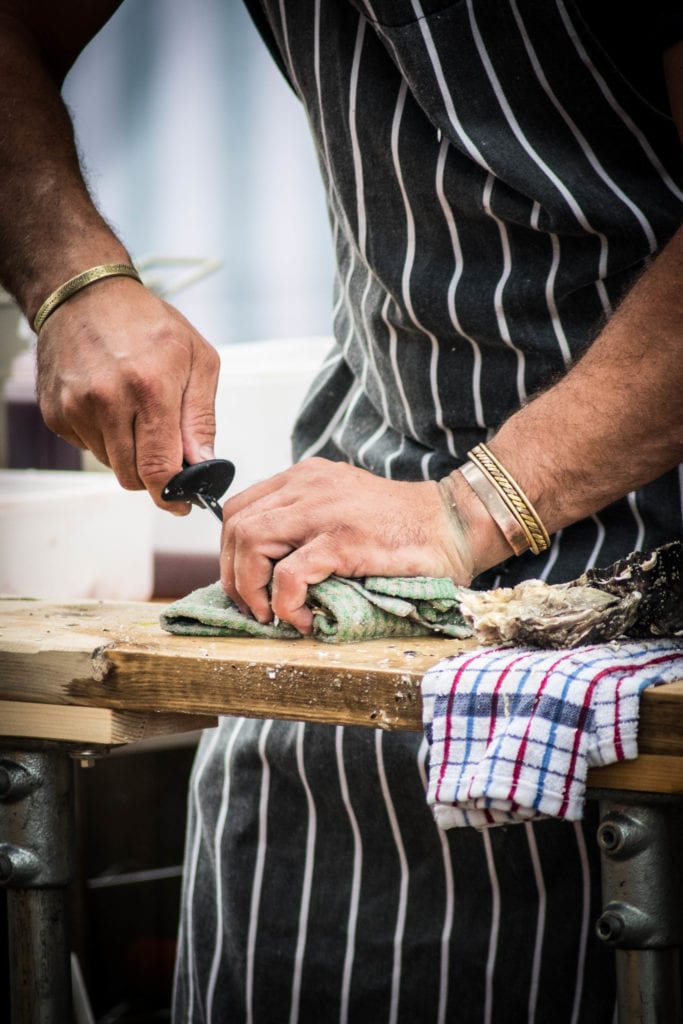Join us at Lymington Seafood Festival 2020 on the 8th and 9th August and enter our NEW Oyster Eating Competition! Simply race down half a dozen oysters and half a pint beer in the fastest time to win!
Can you tell your native from your Pacific oyster? Should you chew or swallow whole? Here’s our expert guide …
Oyster is the common name for a number of different families of salt-water bivalve molluscs that live in marine or brackish habitats. Many, but not all, oysters are in the superfamily Ostreoidea. Some types of oysters are commonly consumed cooked or raw, and are regarded as a delicacy. Some types of pearl oysters are harvested for the pearl produced within the mantle.
Between 1972 and 2006, the Solent supported the largest native oyster fishery in Europe. In 1978, 450 vessels were involved in oyster fishing and 15 million oysters were removed in that year alone. However, since this peak, the oyster population has declined significantly and in 2013 the fishery collapsed.Oysters are ‘ecosystem engineers’ and beds contribute substantially to inshore shallow biodiversity and provide protection and nursery grounds for juvenile fish and other species. Oysters are also filter feeders, and clean waterways removing impurities such as nitrogen.
The two main types of oyster available from fishmongers in the UK are rock (or Pacific) and native oysters.
When picking oysters, look for those with tightly closed shells and avoid those with even the smallest opening. Fishmongers should hold a health certificate that lists the place of harvest and date of production, so if you’re worried about provenance, just ask. Oysters also vary in flavour and texture depending on the water in which they’re grown, so shop around if you want a particular taste profile.
Store oysters in the bottom of the fridge, rounded side down so they don’t leak any juice.
How to prepare an oyster
Closed oysters need to be ‘shucked’, which is something all fishmongers can do for you, but if you fancy taking it on yourself, it’s best to use a specialist oyster knife, which is short and blunt with a finger guard.
Hold the oyster very firmly in a thick cloth to protect your hands, then insert the knife into the hinge, or pointed end, of the oyster
Twist the tip of the knife into the hinge to get a very firm foothold. Once you feel the knife is securely in place, release the pressure from the knife and gently lever or twist the knife to break the muscle of the oyster – you can usually hear the ‘shucking’ noise as the two half shells part.
Loosen the opened oyster from the shell to make it easy to eat.
How to serve oysters
The customary approach to eating oysters is to serve them raw. Typically, raw oysters are served on the half shell with plenty of lemon for squeezing, Tabasco sauce and shallot vinaigrette (mignonette). The briney, sodium-rich flavour of oysters means they partner well with tangy Asian-style dressings

A note on the health benefits of oysters
Oysters are winners on the health front – low in fat and high in protein, they’re also packed with as much iron as red meat, making them a good alternative if you don’t eat meat. As for the aphrodisiac element, this comes from the fact oysters have high zinc levels – thought to be beneficial to male fertility.
More details on how to enter the Lymington Seafood Festival Oyster Competition will be available on our website from May
The world is your oyster!!










 Site by
Site by